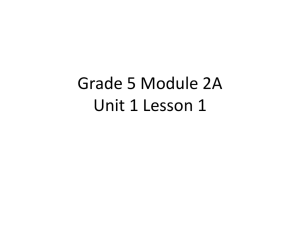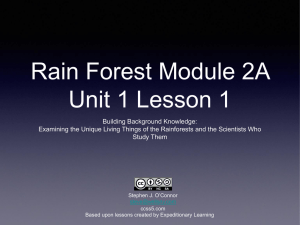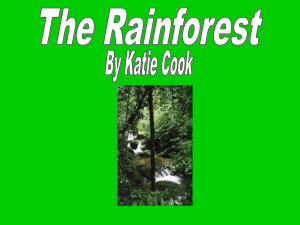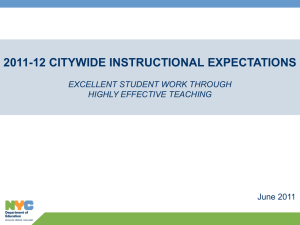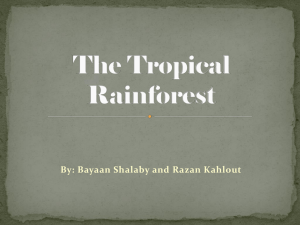Module-2A-Lesson-8
advertisement
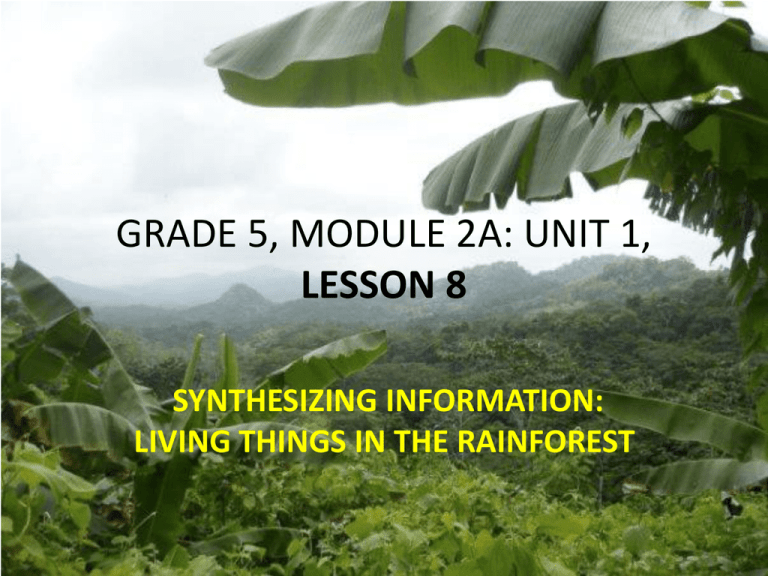
GRADE 5, MODULE 2A: UNIT 1, LESSON 8 SYNTHESIZING INFORMATION: LIVING THINGS IN THE RAINFOREST AGENDA 1. Opening • A. Engaging the Reader: Maps as Informational Text (10 minutes) • B. Review Homework (5 minutes) 2. Work Time • A. Note-Taking for Research (20 minutes) • B. Synthesizing Notes: Paragraph about Unique Life in the • Rainforest (15 minutes) 3. Closing and Assessment • A. What Do We Know about Rainforests from Scientists (5 minutes) • B. Exit Ticket (5 minutes) Learning target: 1. “I can read a map to help inform me as a reader.” What does inform mean? Features of Informational Text anchor chart What features have you seen in an interview? What features have you seen in an article? What features have you seen in a documentary video? • Please look for text features of a map that help you with your learning. • “What text features on the map help you understand information about rainforests?” Text features on a map. •“How is a map a type of informational text?” •“What information can we learn about rainforests from this map?” Please add these features to your features of Informational Text Chart. Please take out your homework from last night. 5 min. Homework Check Please choose a partner that is not at your table. 1. Please share your work with your partner. 2. Look to see if you both used “FEATURES” of the informational next and not just content. 3. Please remove anything that isn’t a feature, and add information if you don’t have enough features or if you and your partner come up with a feature that would be good to add. 4. Use your features of informational text anchor chart in your journal to help you. Some students will share with the class, then you will hand them in. Learning target: 1. “I can take notes on key details from multiple texts about rainforests.” 2. “I can use quotes to create a gist statement from notes about rainforests.” • What are key details? • What is a quote? • Does a quote have to be just words that are spoken in the text? 20 min. Note Taking for Research You will begin to use note-taking as way to record the most essential, or key details, of informational text in this lesson. Remember, the purpose of reading/viewing informational texts is to learn more about a topic, and that one of the reasons you have been working with a variety of informational texts and text features was to learn about unique things found in rainforests. You are going to take notes about those unique living things from the texts your have read and heard. Note-Taking Note-Catcher Locate a quote from the article to support/give more information about this fact. “Live Online Interview with Eve Nilson” - - Frogs are an indicator species Frogs breath through their skin If no frogs, then something is wrong “They’re extremely sensitive to the environment and its changes,” “Any rapid disappearance of frogs is a sign there’s trouble in the environment.” What does this mean? “It’s important to pay attention to frogs in the rainforest, so we know if the pollution in the air might be harmful to us.” Q: Why did you want to study frogs? Eve: I was offered a position studying frogs, but I also felt they were extremely important. They are an indicator species; they're extremely sensitive to the environment and its changes. Any rapid disappearance of frogs is a sign there's trouble in the environment. Also because frogs breathe through their skin. You're able to see more clearly the affects that pollution and acid have. Can identify a unique thing found in the rainforests? Can you identify facts about this unique thing? Note-Taking with your Note-Catcher Make sure that your group members have the following texts: 1. Interview with Sloth Canopy Researcher, Bryson Voirin 2. “Hawaii’s Endangered Happy Face Spider” article 3. The “Great Bear Rainforest Remote Camera Project” video transcript Note-Taking with your Note-Catcher Your goal: to identify key facts/details about the unique things found in rainforests. Use your group members, working with one text at a time, to complete your notecatcher. 15 min. Synthesizing Notes: Paragraph About Unique Life in the Rainforest You will now write a paragraph to inform others about the unique life that exists in the rainforest. Your paragraph should include facts/key details about unique life in the rainforests, from each of the informational texts; and a quote that supports each fact/key detail, from each of the informational texts. You may use anything from the notes in your three-column note-catcher you just created. Your Paragraph You will hand in your paragraph when you have completed it and read it over. KWL Anchor Chart • Can we cross anything off the W column that we’ve learned? • Circle what have haven’t yet. • Want to add anything new to this column? 1. 2. 3. 4. Write on your own. Share with your neighbor. Share with the class. Hand in to your teacher. • What questions do you still have about rainforests? Add any new questions to the W column of the Rainforest KWL chart in your journal. W K L
